Other Interesting Vehicles
Interesting folks at Aerovironment were prime contractors on the GM Impact electric car and makers of the NASA ERAST Pathfinder high altitude solar electric aircraft. Along with Pathfinder and many other bold, eccentric achievements, Paul McCready also created the prize-winning, record-breaking human powered aircraft Gossamer Albatros and Gossamer Penguin. The Impact's drivetrain and controllers were designed and initially hand-built by friend-of-a-friend CalTech grad Alan Cocconi of AC Propulsion.Speaking of human-powered vehicles, check out this Human-Powered Hydrofoil!
Mark Vaughn gives a good very early history of Tesla In the March 2021 Autoweek, including the strong AC Propulsion connections and the Piontek Sportech kit car that their tZero was based on.
Here is an excellent paper summarizing the state of Electric Vehicles (EVs) and near term possibilities (about 2 MB PDF) presented by Mr. Brooks of AC Propulsion at the December 2002 ZEV workshop held by the State of California. The paper was originally at: http://www.arb.ca.gov/msprog/zevprog/2003rule/1202wkshp/brooks.pdf
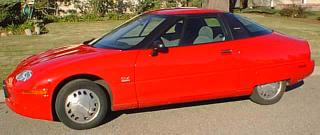
It looks like the first people in Los Altos and perhaps
Santa Clara County to take delivery of a General Motors
EV1,
the production successor to the Impact,
are my mom and dad.
I test drove it with them and found it a fully-developed,
very well-engineered car.
Never mind that it's electric: this is one of the most advanced
cars on the road. The EV1 has a 290lb bonded aluminum space frame,
drag coefficient of 0.19, 137hp electric motor, 0-60 in about 8 seconds.
Torque is 110 foot-pounds from 0-7000 RPM. Redline is 13,500 RPM.
Here are some
highway driving impressions.
Downside: range with lead acid batteries is about 60 miles.
This is however adequate for local errands and commuting.
Range should increase to over 100 miles per full charge with Nickel Metal
Hydride batteries in 2000.
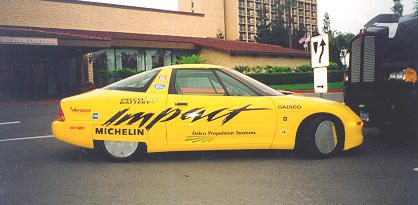
See also my
EV1 directory for more observations, and my
EV1 images, including the 183 MPH world record car.
See also the EV1 Club
page which in addition to archiving information about EV1
has photos of the EV1 graveyard in the desert, where GM crushed and discarded
these wonderful cars.

Sadly, GM built one of the most technologically advanced cars on the planet,
let people drive and appreciate them for a few years, ...
then crushed them!
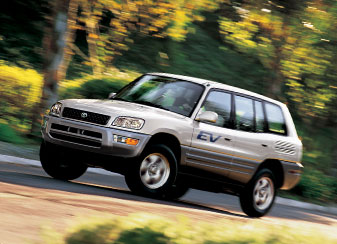
Our lease on the Generation II GM EV1 ran out in December 2002,
so we replaced it by buying a Toyota RAV4 EV.
The sticker price of the car is $43k, but buying an EV
results in $9k from the State of California as part
of the ZIP Zero
Emissions Vehicle Incentive Program,
and a $4k Federal income tax credit, bringing the
realistic price to about $35k.
Here is my
mini-review of the RAV4 EV.
In a nutshell, it is an outstandingly good car.
If you purchased or leased an Alternative Fuel Vehicle (AFV) in California from 1999 through 2002, read how you can save about 50% on your Vehicle License Fees. This includes the RAV4 EV and other vehicles powered by electricity, natural gas and other clean sources of energy.
Note that Toyta is also crushing nice, low-mileage RAV4 EVs that are coming off fleet leases. Only consumer RAV4 EVs will be spared from the crusher. Honda too has crushed their EV Plus street cars. I'm not going to say that the automakers are trying to suppress this technology, but it certainly could be interpreted that way.... The waste of crushing these outstanding cars is certainly sad.
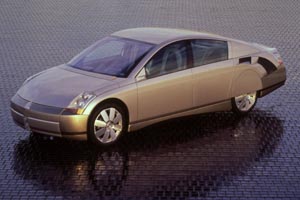
GM's PNGV project car
Precept
betters the EV1's already amazing coefficient of drag,
achieving a stunning 0.163 through boundary layer control,
lots of clever and stylish vortex generation,
and some filling of the base wake.
The boundary layer control and base wake fill are accomplished
by the same means as cooling. This hybrid diesel/electric
has drivetrain and heat exchangers (radiators) for engine cooling
at the back of the car.
Electric fans pull air in from the sides,
re-attaching the side airflow around where it would have otherwise
detached and become turbulent,
reducing the apparent cross-sectional area of the tail,
cooling the engine, and filling the base wake.
These clever drag reduction regimes are accomplished
simultaneously with necessary cooling.
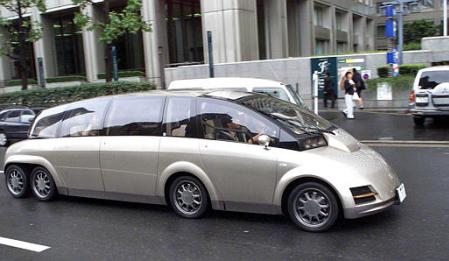
Three little words, Sully:
Eight Wheel Drive.
Mike from
Monsters, Inc.
might like this 8 wheel drive Li-Ion battery powered 192 MPH
electric.
KAZ
features wheel-integrated motors,
individual wheel steering, and self-contained power and contollers in a
sub-floor module.
Another even more advanced project is GM's Autonomy platform, which features fuel cell power, wheel-hub integrated motors, total drive by wire: steering, braking, speed. First demonstration vehicle is the van-like Hy-Wire. The body attaches to the platform via a few hardpoints and some electrical connections for control. Different bodies can be attached modularly on the same platform, creating a variety of cars, from sporty to van. Thus Autonomy can form the underlying structure of many different vehicles.
Note however that according to Alec N. Brooks presentation to the California Air Resources Board (CARB), Battery Electric Vehicles (BEVs) are four times more energy efficient than Fuel Cell Vehicles. Physicist Ulf Bossel finds similar energy efficiency results for Fuel Cell Vehicles (FCVs), with FCVs powered with gaseous Hyrdogen using 3 times more energy than BEVs, and liquid Hydrogen FCVs using 4 times more energy than BEVs when the total energy cycle of each type is included.
Here's another page of mine with information and links about Hypercars, which are highly-efficient, high-tech cars of the future.